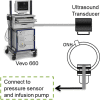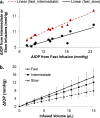Correlation between biomechanical responses of posterior sclera and IOP elevations during micro intraocular volume change
- PMID: 24130185
- PMCID: PMC3816617
- DOI: 10.1167/iovs.13-12441
Correlation between biomechanical responses of posterior sclera and IOP elevations during micro intraocular volume change
Abstract
Purpose: This study tested the hypothesis that intraocular pressure (IOP) elevations, induced by controlled increase of intraocular volume, are correlated with the biomechanical responses of the posterior sclera.
Methods: Porcine globes were tested within 48 hours postmortem. The first group of globes (n = 11) was infused with 15 μL of phosphate-buffered saline at three different rates to investigate rate-dependent IOP elevations. The second group (n = 16) was first infused at the fast rate and then underwent inflation tests to investigate the relationship between IOP elevations (ΔIOP) and scleral strains. The strains in the superotemporal region of the posterior sclera were measured by ultrasound speckle tracking. Linear regression was used to examine the association between ΔIOP due to micro-volumetric infusion and the scleral strains at a specific inflation pressure.
Results: The average ΔIOP was 14.9 ± 4.3 mm Hg for the infusion of 15 μL in 1 second. The ΔIOP was greater for the faster infusion rates but highly correlated across different rates (P < 0.001). A significant negative association was found between the ΔIOP and the tangential strains in both the circumferential (R(2) = 0.54, P = 0.003) and meridian (R(2) = 0.53, P = 0.002) directions in the posterior sclera.
Conclusions: This study showed a substantial increase in IOP, with a large intersubject variance during micro-volumetric change. A stiffer response of the sclera was associated with larger IOP spikes, providing experimental evidence linking corneoscleral biomechanics to IOP fluctuation. In vivo measurement of corneoscleral biomechanics may help better predict the dynamic profile of IOP.
Keywords: IOP fluctuation; glaucoma posterior segment; scleral biomechanics.
Figures







Similar articles
-
Ultrasonic measurement of scleral cross-sectional strains during elevations of intraocular pressure: method validation and initial results in posterior porcine sclera.J Biomech Eng. 2012 Sep;134(9):091007. doi: 10.1115/1.4007365. J Biomech Eng. 2012. PMID: 22938374 Free PMC article.
-
Corneoscleral stiffening increases IOP spike magnitudes during rapid microvolumetric change in the eye.Exp Eye Res. 2017 Dec;165:29-34. doi: 10.1016/j.exer.2017.08.015. Epub 2017 Aug 30. Exp Eye Res. 2017. PMID: 28864177 Free PMC article.
-
Regional Deformation of the Optic Nerve Head and Peripapillary Sclera During IOP Elevation.Invest Ophthalmol Vis Sci. 2018 Jul 2;59(8):3779-3788. doi: 10.1167/iovs.18-24462. Invest Ophthalmol Vis Sci. 2018. PMID: 30046819 Free PMC article.
-
Posterior scleral biomechanics and the translaminar pressure difference.Int Ophthalmol Clin. 2014 Winter;54(1):73-94. doi: 10.1097/IIO.0b013e3182aabef4. Int Ophthalmol Clin. 2014. PMID: 24296373 Review. No abstract available.
-
Importance of accurately assessing biomechanics of the cornea.Curr Opin Ophthalmol. 2016 Jul;27(4):285-91. doi: 10.1097/ICU.0000000000000282. Curr Opin Ophthalmol. 2016. PMID: 27152485 Review.
Cited by
-
Influence of Age on Ocular Biomechanical Properties in a Canine Glaucoma Model with ADAMTS10 Mutation.PLoS One. 2016 Jun 6;11(6):e0156466. doi: 10.1371/journal.pone.0156466. eCollection 2016. PLoS One. 2016. PMID: 27271467 Free PMC article.
-
Cyclic Pattern of Intraocular Pressure (IOP) and Transient IOP Fluctuations in Nonhuman Primates Measured with Continuous Wireless Telemetry.Curr Eye Res. 2019 Nov;44(11):1244-1252. doi: 10.1080/02713683.2019.1629594. Epub 2019 Jun 19. Curr Eye Res. 2019. PMID: 31170817 Free PMC article.
-
Mapping 3D Strains with Ultrasound Speckle Tracking: Method Validation and Initial Results in Porcine Scleral Inflation.Ann Biomed Eng. 2016 Jul;44(7):2302-12. doi: 10.1007/s10439-015-1506-1. Epub 2015 Nov 12. Ann Biomed Eng. 2016. PMID: 26563101 Free PMC article.
-
Intraocular pressure effect of intravitreal conbercept injection for retinopathy of prematurity.Front Pharmacol. 2023 May 30;14:1165356. doi: 10.3389/fphar.2023.1165356. eCollection 2023. Front Pharmacol. 2023. PMID: 37324456 Free PMC article.
-
Three-Dimensional Strains in Human Posterior Sclera Using Ultrasound Speckle Tracking.J Biomech Eng. 2016 Feb;138(2):021015. doi: 10.1115/1.4032124. J Biomech Eng. 2016. PMID: 26632258 Free PMC article.
References
-
- Anderson DR, Grant WM. The influence of position on intraocular pressure. Invest Ophthalmol. 1973; 12: 204–212 - PubMed
-
- Coleman DJ, Trokel S. Direct-recorded intraocular pressure variations in a human subject. Arch Ophthalmol. 1969; 82: 637 - PubMed
-
- Weinreb RN, Cook J, Friberg TR. Effect of inverted body position on intraocular pressure. Am J Ophthalmol. 1984; 98: 784–787 - PubMed
Publication types
MeSH terms
Grants and funding
LinkOut - more resources
Full Text Sources
Other Literature Sources

